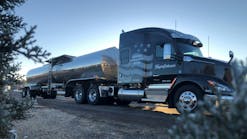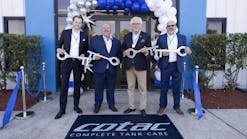Owned and operated by Rescar Companies, the new Channelview wash rack was built to clean virtually any liquid cargo transported in rail tankcars, and this includes both hazardous and non-hazardous products. The new wash rack replaced an older cleaning facility that no longer met Rescar's needs. Channelview is one of three locations where Rescar replaced older wash facilities over the past seven years.
“Our cleaning capacity in Channelview has increased from five tankcars a day to as many as 16,” says Kevin Wilck, Rescar vice-president. “We spent two years building this facility, but we wanted to get it up and running as soon as possible. We see busy times right now from the first quarter of 2012 and beyond. Rail fleet utilization is at near record highs, builders of new tankcars are expanding, and a huge cycle of federally mandated tankcar requalification is about to hit.
“The cleaning system in Channelview was designed with the current and future needs of Fortune 500 and major chemical shippers in mind. They need Rescar to properly handle a wide range of potentially harmful products, as well as support their sustainability initiatives. For example, some of the compounds we remove can be recycled for processing in numerous industries. Channelview's sophisticated cleaning system can return more of what was once considered waste to productive use.”
The Channelview tankcar cleaning system is an integral part of Rescar's 42-acre full-service railcar shop complex. The facility has five miles of track that can accommodate 450 tankcars and has approximately 200,000 square feet under roof with room for up to 90 cars. Located in the heart of the petroleum, petrochemical, and chemical refining and processing industries of the Gulf Coast near Houston, Texas, the Channelview facility provides a comprehensive menu of services including railcar repair, interior and exterior coating applications, cleaning, testing, inspection, and non-destructive testing services.
The tankcars that come through the Channelview wash rack range in capacity from 13,000 gallons to 33,000 gallons. While some tankcars are sent in just for cleaning, most are there for a broader range of repair and maintenance services.
“Tankcars come in for cleaning when there is a change of service or the cars are coming off lease,” Wilck says. “Cleaning is required when cars are repainted or interior linings are replaced. They also get cleaned when they arrive for repair, modification, or mandated requalification.”
In addition to Channelview, Rescar has full-service railcar shops in Gordon, Georgia; Chicago, Illinois; Elk Mills, Maryland; DuBois, Pennsylvania; and Longview and Orange, Texas. The company also has numerous field services and FAST Tracks locations in the United States and Canada.
With 21,000 square feet under roof, the new Channelview wash rack is the largest in the Rescar system. The company also built new wash racks over the past several years at the DuBois and Orange locations. All of the full-service facilities have tankcar cleaning capability, and company also operates mobile tankcar cleaning systems.
The new cleaning system in Channelview replaced a much smaller facility that had been in use for many years. “We had a four-car wash rack at Channelview, but it was badly damaged by Hurricane Ike in 2008,” Wilck says. “It gave us an opportunity to build a modern facility and incorporate some of the improvements we added when we built new wash racks in Orange and DuBois.”
Cleaning uniformity
Most importantly, Rescar had a chance to begin implementing a more uniform tankcar cleaning process across the entire company. “We still have two additional tankcar cleaning facilities to replace, but we are definitely seeing the benefits of the improvements,” Wilck says.
Designed and built in-house, the Channelview wash rack uses a vat-style cleaning system that consists of four 13,000-gallon railcar tanks on the ground level. The closed-loop cleaning system ensures full containment of product residues, vapors, and cleaning solutions.
The wash rack was designed for simplicity of operation with features such as manually-actuated valves. “We don't have a lot of automation in our cleaning system,” Wilck says. “Automated systems are more costly to maintain, because we are handling a lot of corrosive materials. Besides, tankcar cleaning is a hands-on job, and workers need to be monitoring operations at all times.”
Above the cleaning system tanks is a wide galvanized steel mezzanine where wash workers operate the valves and monitor the cleaning process. The wash rack currently employs eight workers on a single 10-hour shift. With sufficient demand, the wash rack crew could be increased to run the facility around the clock.
Cleaning equipment includes Butterworth spinners, electrically powered Gould's pumps, Dekker vacuum pumps for collecting vapors, and ball valves with Teflon-seat balls. “We lease the spinners, and one reason is that we get two rebuilds a year per machine,” Wilck says. “We operate the spinners at 85 psi to 110 psi depending on the product being cleaned. We like the Gould's pumps because we can get about five years out of them with proper maintenance. Vacuum pumps last about three years due to the very corrosive nature of the vapors they handle. Ball valves are easier to maintain, and the Teflon seats make them more corrosion resistant.”
Cleaning stations
The wash rack is roughly divided into sections, each of which handles different tank cleaning requirements. The first section is dedicated to acids and is designed to handle two tankcars at a time. Cleaning capabilities at this station include an acid/caustic scrubber and a carbon filter that were designed and built in-house.
Four car spots are used for general cleaning of chemical and petroleum tankcars. Rescar's Channelview wash rack cleans a lot of lube oils and alcohols, as well as various chemicals.
Each tankcar is thoroughly purged of product residue and vapors before cleaning begins. Residues are drummed to be recycled or sent out for approved disposal. Chemical and petroleum vapors are sent to a flare behind the wash rack for destruction. Only after residues and vapors are removed do wash workers inspect the condition of the tank interior and begin the cleaning process.
Detergent is used in some of the chemical tank cleaning, and diesel presolve is used to clean out heavy lube oils. Caustic washes are used as needed. A detailed cleaning procedure is created by computer for each tankcar.
“We developed our own computer application for the tank cleaning process,” Wilck says. “We print out a customized cleaning menu for each tankcar targeting the specific product transported in that tankcar. We also have an MSDS (material safety data sheet) for each tankcar.”
Cleaning for a typical general purpose chemical tankcar takes about four hours from start to finish. It begins with the setup process that includes heel and vapor removal. Next is the wash and rinse process that sometimes includes steam. Some hand cleaning may be required to remove stains or built-up product. Finally, the clean tankcar is cooled and dried.
The last two railcar spots in the wash rack are for difficult cleanings or dig-outs. “We get quite a few tankcars with large amounts of built-up non-hazardous product,” Wilck says. “Product has to be dug out by hand, and it's a job that can take days.”
The building housing the wash rack has a dedicated bay used for blasting with crushed coal to remove coatings and linings on railcars. In addition to the new wash rack, the Channelview facility has a large area for degassing pressure tankcars that are used to transport products such as LP-gases.
With the tankcar cleaning upgrades, Rescar's Channelview facility is busier than ever. “The new cleaning facility in Channelview is part of our long-range strategic effort to give our tankcar customers the services they need,” says Joseph S Schieszler Jr, Rescar president and chief executive officer. ♦











